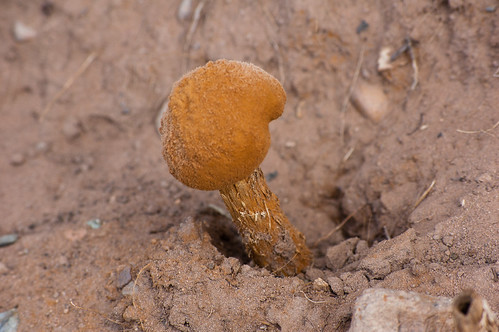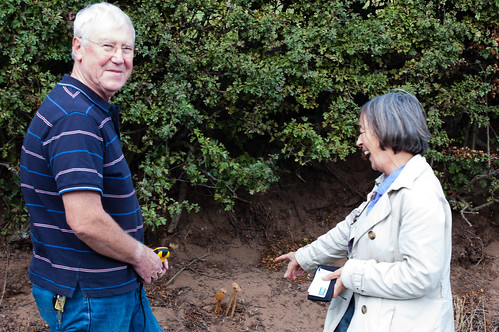The fungi pictured here are sandy stiltballs (Battarraea phalloides) which is a very rare fungus in Britain.
https://www.flickr.com/photos/davea2007/6117257592
It is not in fact a conventional “toadstool” type fungus, with gills or pores under the cap for dispersing the spores. Instead, it is related to puffballs – it is a puffball on a stem.
Its preferred habitat is sandy soil. The lighter sprinkling which can be seen on the “cap” of some of the fresher specimens is not, as I thought, sand from the soil. It is spores.
New fruiting bodies were growing with others which seemed to be several days old.
These more mature fruiting bodies had a more bleached appearance, as often with fungi.
I noticed some of these fungi while cycling down a quiet country lane in south Shropshire.
It’s only the second time sandy stiltballs have been recorded in Shropshire.
The other known site is only a few miles away from this one.
https://www.flickr.com/photos/davea2007/6117252466
Roy Mantle, Shropshire County Recorder for Fungi, and Jefny admire one of the clumps of fruiting bodies.
Thanks to Jefny for identifying the species, and Roy Mantle for an interesting afternoon when we went to visit the site.









One reply on “Sandy stiltballs – a rare find”
It would be interesting to discover what Battarrea is feeding upon in this instance – the site shown in the last photo is very barren leading me to believe it is obtaining nutrients from the roots of the nearby shrub. But this shrub is very much alive and Battarrea is said to be saprophytic – i.e., feeds on dead organic matter.
I have made several attempts to dig away the soil beneath the fruiting body to see if I could trace thickened mycelium back to a source without success but we need Natural England to give a young student a bursary to make a proper job of this so that people who manage these sites understand better Battarrea habitat requirements.
Sometimes, I have found isolated spots at the base of an oak tree where Battarrea occur and I have removed ‘unwanted’ vegetation such as common mallow and nettles in order to ‘help’ the fungus – but the fungus never showed again. So was it obtaining its nutrients from dying vegetation rather than dead tree roots ? There is so much to learn still about this and many other fungi.
I’d be grateful if you could get back to me to let me know how frequently/infrequently Battarrea has occurred at your site shown above since the photo was taken.
Neil Mahler